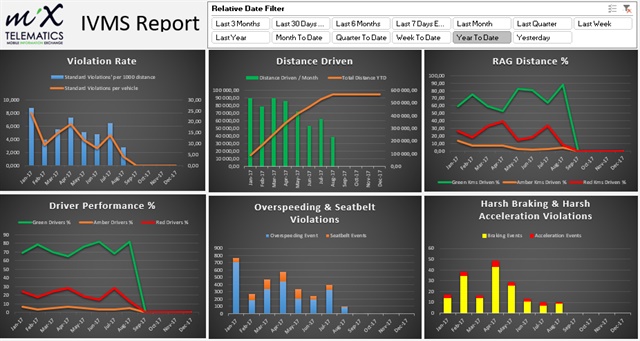The Top 10 KPIs Every Fleet Manager Should Track
December 2017, TruckingInfo.com - Feature
One big benefit of the move to Electronic Logging Devices (ELDs) is the ease with which fleet managers can now collect data to help improve operations. The data can be overwhelming, however, and we’re fielding a lot of questions from fleet managers on what’s most important, and how to leverage the data they are now collecting.
We think about data across three broad categories: Safety, Efficiency and Compliance. In an ELD world, the data typically comes from an On-Board Computer (OBC) on each vehicle that tracks metrics such as speed, idling, fuel usage, driver behavior, GPS location and more. The data flows to fleet management software installed on the OBC and is then delivered to fleet managers via wifi, cellular network or satellite, in some cases in real time.
While KPIs will differ by fleet size and vertical, here are the most common – the ones we believe every fleet should be tracking.
Safety KPIs
Driver behavior is the biggest category within Safety – fleets that monitor driver behavior and use the data they collect for driver coaching are best poised to improve their overall safety profile.
The top KPIs for safety are all related to driver behavior, and include:
- Speeding incidents
- Harsh acceleration and braking incidents
- Corner handling incidents
- Crashes
Ideally, this data should be conveyed to fleet managers in real time – especially crashes.
In addition to collecting this data, fleet managers should also publish weekly Driver Safety Scorecards – exception-based reports that include data on the frequency of these events, per driver.
 |
These scorecards should be posted in driver break rooms and other common areas, to create completion among drivers (often fleets will give their best drivers rewards such as cash gifts or extra paid time off). Some fleets are creating safety competitions, leveraging gamification app features in their fleet management solutions.
Of course, more detailed scorecards should also be shared with individual drivers, for educational and coaching purposes. Some fleets call these RAG (Red, Amber, Green) reports, for the colors used to indicate each driver’s risk profile. Whatever you call them, they are essential element for driver coaching and improving driver behavior.
Fleets that have added in-cab video to their ELD solution can configure their systems to automatically append video to the record of each triggered event – so fleet managers and drivers can see what was happening inside and outside the cab when an event (such as a crash) occurred.
Efficiency KPIs
When it comes to Efficiency, we recommend that fleets track:
- Fuel economy per vehicle, including idling time
- Empty miles
- Fleet asset utilization
Most fleets we work with review reports on fuel economy and maintenance weekly, and empty miles and fleet asset utilization either monthly or quarterly.
Fuel economy and maintenance data can help managers identify gas-guzzling behaviors such as speeding and excessive idling, so that drivers can be trained to avoid them. Reducing those behaviors in turn reduces wear and tear on vehicles, decreasing maintenance requirements. Most importantly, all of this leads to safer driving and fewer crashes.
Obtaining a clear view of empty miles and how assets are used on a day-to-day basis can help fleets optimize asset utilization and, in some cases, allow companies to reduce the number of vehicles in their fleet – further reducing costs such as fuel, maintenance and insurance.
Compliance KPIs
Here, fleets need to track:
- Available Hours of Service (HOS)
- HOS violations
- Unassigned mileage by vehicle
HOS is most important, and is the main objective of the ELD Mandate. Dispatchers should be looking at HOS at least daily. Best practice is to look at this data live, in real time as they dispatch, since HOS can change during a day.
We recommend a weekly review of violations – virtually all fleets will have them, not due to failures in their processes, but often because drivers simply don’t obey the rules. For example: if a driver is going to run out of hours in 30 minutes, but he’s 45 minutes from home, he’s going to keep going. Fleets don’t have to report these violations – but they do need to track them, in case there is a DOT audit.
Unassigned mileage by vehicle is another key provision of the ELD Mandate. The FMCSA wants ALL driving time captured. If your fleet has exceptions, you need to be aware of them (and ideally get that mileage assigned to a driver before your next audit).
Most importantly, be sure to use the data your ELDs collect
In certain sectors, there are other important KPIs. For instance, in food delivery, fleets should track on-time arrivals and monitor reefer temperature. But generally, everything you want to track will fall under Safety, Efficiency or Compliance.
The ability to set up alerts within your chosen ELD platform will assist greatly – especially alerts for safety issues and impending HOS violations. Having insight into those events will help ensure fleets can reduce or prevent them.
Reporting is also crucial. All of the Top 10 KPIs can and should be automatically collected by your ELD solution, which should in turn offer pre-configured reports, making the reporting process simple and automated. Some offer the ability to craft your own custom report templates – especially useful for larger fleets, or power users of analytics.
The ELD era will bring about a data deluge, which has a ton of potential to help fleets improve safety and operations. But if fleets don’t harness and use the data, it’s just noise.

No comments:
Post a Comment